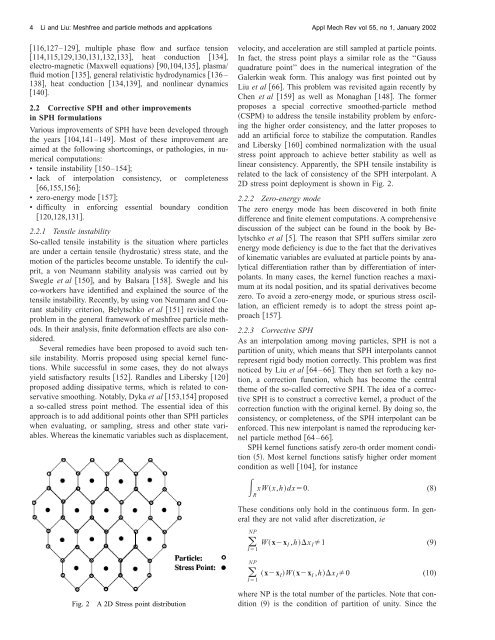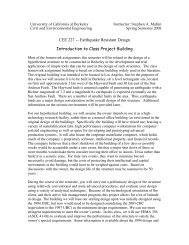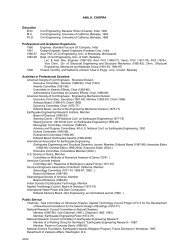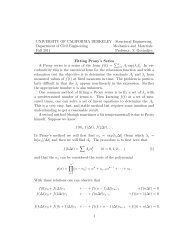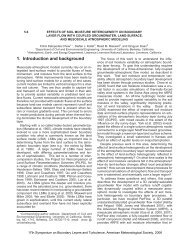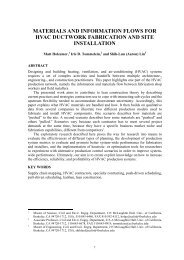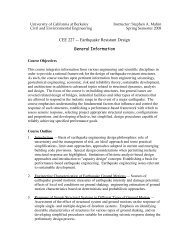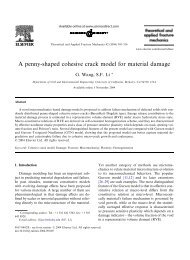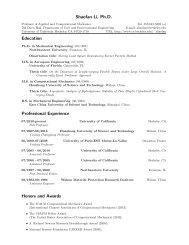Meshfree and particle methods and their applications - TAM ...
Meshfree and particle methods and their applications - TAM ...
Meshfree and particle methods and their applications - TAM ...
You also want an ePaper? Increase the reach of your titles
YUMPU automatically turns print PDFs into web optimized ePapers that Google loves.
4 Li <strong>and</strong> Liu: <strong>Meshfree</strong> <strong>and</strong> <strong>particle</strong> <strong>methods</strong> <strong>and</strong> <strong>applications</strong> Appl Mech Rev vol 55, no 1, January 2002<br />
116,127–129, multiple phase flow <strong>and</strong> surface tension<br />
114,115,129,130,131,132,133, heat conduction 134,<br />
electro-magnetic Maxwell equations 90,104,135, plasma/<br />
fluid motion 135, general relativistic hydrodynamics 136–<br />
138, heat conduction 134,139, <strong>and</strong> nonlinear dynamics<br />
140.<br />
2.2 Corrective SPH <strong>and</strong> other improvements<br />
in SPH formulations<br />
Various improvements of SPH have been developed through<br />
the years 104,141–149. Most of these improvement are<br />
aimed at the following shortcomings, or pathologies, in numerical<br />
computations:<br />
• tensile instability 150–154;<br />
• lack of interpolation consistency, or completeness<br />
66,155,156;<br />
• zero-energy mode 157;<br />
• difficulty in enforcing essential boundary condition<br />
120,128,131.<br />
2.2.1 Tensile instability<br />
So-called tensile instability is the situation where <strong>particle</strong>s<br />
are under a certain tensile hydrostatic stress state, <strong>and</strong> the<br />
motion of the <strong>particle</strong>s become unstable. To identify the culprit,<br />
a von Neumann stability analysis was carried out by<br />
Swegle et al 150, <strong>and</strong> by Balsara 158. Swegle <strong>and</strong> his<br />
co-workers have identified <strong>and</strong> explained the source of the<br />
tensile instability. Recently, by using von Neumann <strong>and</strong> Courant<br />
stability criterion, Belytschko et al 151 revisited the<br />
problem in the general framework of meshfree <strong>particle</strong> <strong>methods</strong>.<br />
In <strong>their</strong> analysis, finite deformation effects are also considered.<br />
Several remedies have been proposed to avoid such tensile<br />
instability. Morris proposed using special kernel functions.<br />
While successful in some cases, they do not always<br />
yield satisfactory results 152. R<strong>and</strong>les <strong>and</strong> Libersky 120<br />
proposed adding dissipative terms, which is related to conservative<br />
smoothing. Notably, Dyka et al 153,154 proposed<br />
a so-called stress point method. The essential idea of this<br />
approach is to add additional points other than SPH <strong>particle</strong>s<br />
when evaluating, or sampling, stress <strong>and</strong> other state variables.<br />
Whereas the kinematic variables such as displacement,<br />
velocity, <strong>and</strong> acceleration are still sampled at <strong>particle</strong> points.<br />
In fact, the stress point plays a similar role as the ‘‘Gauss<br />
quadrature point’’ does in the numerical integration of the<br />
Galerkin weak form. This analogy was first pointed out by<br />
Liu et al 66. This problem was revisited again recently by<br />
Chen et al 159 as well as Monaghan 148. The former<br />
proposes a special corrective smoothed-<strong>particle</strong> method<br />
CSPM to address the tensile instability problem by enforcing<br />
the higher order consistency, <strong>and</strong> the latter proposes to<br />
add an artificial force to stabilize the computation. R<strong>and</strong>les<br />
<strong>and</strong> Libersky 160 combined normalization with the usual<br />
stress point approach to achieve better stability as well as<br />
linear consistency. Apparently, the SPH tensile instability is<br />
related to the lack of consistency of the SPH interpolant. A<br />
2D stress point deployment is shown in Fig. 2.<br />
2.2.2 Zero-energy mode<br />
The zero energy mode has been discovered in both finite<br />
difference <strong>and</strong> finite element computations. A comprehensive<br />
discussion of the subject can be found in the book by Belytschko<br />
et al 5. The reason that SPH suffers similar zero<br />
energy mode deficiency is due to the fact that the derivatives<br />
of kinematic variables are evaluated at <strong>particle</strong> points by analytical<br />
differentiation rather than by differentiation of interpolants.<br />
In many cases, the kernel function reaches a maximum<br />
at its nodal position, <strong>and</strong> its spatial derivatives become<br />
zero. To avoid a zero-energy mode, or spurious stress oscillation,<br />
an efficient remedy is to adopt the stress point approach<br />
157.<br />
2.2.3 Corrective SPH<br />
As an interpolation among moving <strong>particle</strong>s, SPH is not a<br />
partition of unity, which means that SPH interpolants cannot<br />
represent rigid body motion correctly. This problem was first<br />
noticed by Liu et al 64–66. They then set forth a key notion,<br />
a correction function, which has become the central<br />
theme of the so-called corrective SPH. The idea of a corrective<br />
SPH is to construct a corrective kernel, a product of the<br />
correction function with the original kernel. By doing so, the<br />
consistency, or completeness, of the SPH interpolant can be<br />
enforced. This new interpolant is named the reproducing kernel<br />
<strong>particle</strong> method 64–66.<br />
SPH kernel functions satisfy zero-th order moment condition<br />
5. Most kernel functions satisfy higher order moment<br />
condition as well 104, for instance<br />
<br />
R<br />
xWx,hdx0. (8)<br />
These conditions only hold in the continuous form. In general<br />
they are not valid after discretization, ie<br />
NP<br />
I1<br />
Wxx I ,hx I 1 (9)<br />
NP<br />
I1<br />
xx I Wxx I ,hx I 0 (10)<br />
Fig. 2<br />
A 2D Stress point distribution<br />
where NP is the total number of the <strong>particle</strong>s. Note that condition<br />
9 is the condition of partition of unity. Since the


